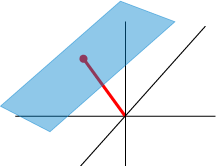Section1.2Week 1 (May 21-25)
This week, you'll get oriented to the course, gain access to all the technological tools you'll need for the semester, get to know your instructor and classmates, and -- oh yeah -- do a bit of mathematics, solving some elementary systems of linear equations.
To do this week:
- By Wednesday 5/23: Create accounts at the services listed in Hardware and Software.
- By Wednesday 5/23: Introduce yourself by recording a short video here: https://flipgrid.com/7ac219
- By Thursday 5/24: Read and annotate the following.
- 1.1 What can we expect: https://via.hypothes.is/http://merganser.math.gvsu.edu/david/linear.algebra/ula/ula/sec-expect.html
- 1.2 Finding solutions to systems: https://via.hypothes.is/http://merganser.math.gvsu.edu/david/linear.algebra/ula/ula/sec-finding-solutions.html
- NB: When annotating, be sure you have selected the "Linear Algebra" group and not "Public," or I won't be able to see your annotations!
- On Friday 5/25: Watch Lecture 1 below (Subsection 1.2.2 and Subsection 1.2.3).
- By Friday 5/25: Create your Portfolio 1 on Blackboard and complete your Learning Narrative 1 pre-portfolio writing (see Criteria for Excellence for details)
- By Friday 5/25: Submit Quiz 1 on Blackboard
- Work on WeBWoRK exercises (see Blackboard) to prepare for Quiz 1. Post and respond to your classmates' questions on Piazza at http://piazza.com/bridgew/summer2018/math202.
Subsection1.2.1Getting Started
Your work this semester to learn linear algebra falls into essentially four phases.
- Introduction. At the beginning of each portfolio there'll be a video assignment in Flipgrid where you'll have the opportunity to talk about your understanding of the upcoming material.
- Read and Discuss. Get your first exposure to new material by reading our online textbook and annotating (posing and responding to questions, and sharing your hints, feedback, and video resources you found helpful) using the Hypothes.is platform.
- Practice and Collaborate. Work on mastering computational learning standards by completing WeBWoRK problem sets. And, work on writing up conceptual and proof-based material using Overleaf. For both, discuss in Piazza as questions and trouble spots arrive; this is where your instructor and classmates will be most present to give you assistance!
- Certify. Via Blackboard: download, complete, submit, and receive instructor feedback on quiz and exam problems. This is also where you'll submit your finished portfolios and project assignments throughout the semester.
